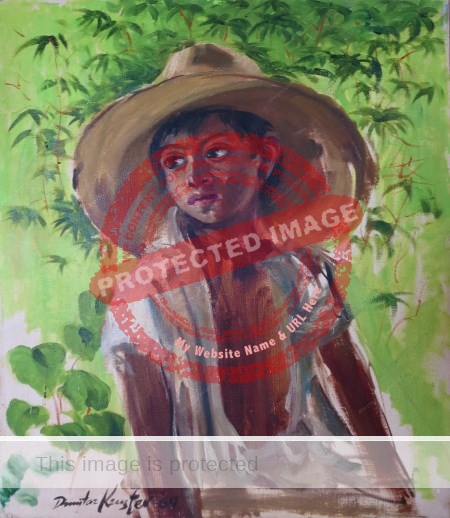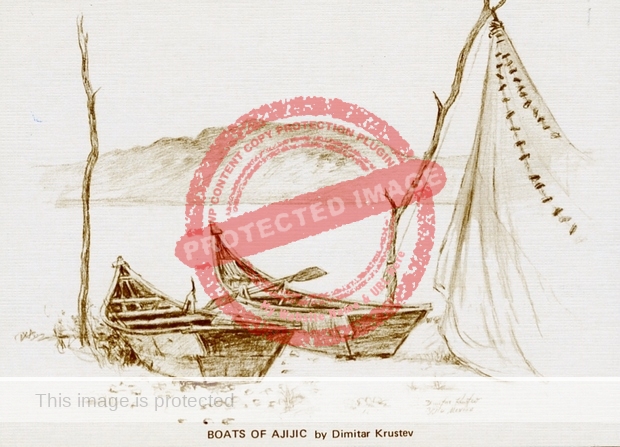Dimitar Iliev Krustev (1920-2013) was born in Sofia, Bulgaria, on 12 January 1920 and died in Ajijic on 11 February 2013. After studying at The Natioual Academy of Art for Portrait Painting in Sofia, Krustev served in the army under German rule for three years during the second world war. He moved to the US in 1947 to take a bachelor’s degree in commercial art at Kent State University, and then completed a masters degree in art history at the University of Iowa.

Dimitar Krustev. 1969. Portrait of a young man. Reproduced by kind permission of Ricardo Santana.
Krustev took US citizenship and he and his wife, Helen Marie, a former student, lived most of their married life in Des Moines, Iowa. Krustev worked as a commercial artist for the Des Moines-based magazine Better Homes and Gardens for nine years before opening the Des Moines Krustev Studio of Art. Krustev, who specialized in portraiture, loved teaching art, and many of his hundreds of students went on to enjoy considerable commercial and personal success. Krustev also enjoyed leading art study groups to Europe, Ajijic and elsewhere.
In the 1960s, as a member of The Explorer’s Club, Krustev began to travel to distant locations to document, photograph and paint the indigenous peoples of the Americas. In 1968 he became the first person known to have successfully navigated the Usumacinta River from its headwaters in Guatemala to the Gulf of México. Krustev’s fascination with people living in near isolation in what are commonly perceived as extreme environments led to his particular interest in the plight of the Lacandon Maya who live in the rain forest of Chiapas in southern Mexico.
Krustev’s experiences resulted in several books, including River of the Sacred Monkey (1970), Voices in the Night (1992), The Journals of Dimitar Krustev, an Artist–Explorer (Volume One) (1996), Black Hand Over the Jungle (1997), and Lacondón Journal 1969: From the Journals of Dimitar Krustev Artist-Explorer, published by Editorial Mazatlán in December 2012, only months before the artist’s death. His books and journals, supported by exquisite portraits, provide extraordinary insights into the changing daily lifes of the people who befriended him at a time when their traditional way of life was under siege from modernizing influences. Krustev is also the subject of a film titled The Bulgarian Gaugin.
After traveling back and forth between Des Moines and Ajijic for almost thirty years, Krustev and his wife established their home and studios in Ajijic in the year 2000. Ajijic became their base for more traveling, painting, teaching, and many joint shows. Among the artists inspired by Krustev are Pauli Zmolek (who painted her own scenes of the Chapala area) and Lois Black.

Dimitar Krustev. Boats of Ajijic. (Greetings card)
This conté drawing titled Boats of Ajijic shows typical fishing boats and fishing nets on the shore of lake, with Cerro Garcia in the background.
Krustev’s first major show in Mexico was in 1972 when he presented portraits and landscapes at the Mexican-North American Cultural Institute in the Zona Rosa, Mexico City. He also exhibited in Guadalajara and throughout Europe and the USA.
His earliest recorded exhibit in Ajijic (which accompanied a showing of his film of the Lacandon Maya) was at the Posada Ajijic in August 1977. He first ran workshops in Ajijic at about this time. Four years later, in 1981, he advertised an 11-day workshop in Ajijic for $552.60 a person; the fee included air fare from Omaha, room and art instruction.
In 1989, Krustev and his wife, Helen Marie Krustev, held a joint showing of their work at the Art Studio Galeria in San Antonio Tlayacapan. They held another noteworthy joint exhibit, titled Caras de México, in the lobby of the Las Hadas hotel in Manzanillo in February 2000.
Several of their shows in Mexico were organized by Katie Goodridge Ingram, who ran two successful art galleries in Ajijic—Galería del Lago and Mi México—for many years. Ingram explained to me that “Many of his works were a combination of conté and charcoal and pastels, though he also painted in oils” and that she was enthralled by his work among the Lacandon:
partly because of their inherent beauty and their attempts to preserve their old ways and partly because of the tragedy involved in the confluence of two cultures. I admired the adventurer who went into the jungle and, fearing the imminent extinction of these people, drew the wonderful faces, garb and lifestyle of the Lacandon Indians.”
[Katie Goodridge Ingram is the author of According to Soledad: memories of a Mexican childhood, a fascinating fictionalized memoir of growing up in Ajijic in the 1940s and 1950s.]
Krustev’s work has been exhibited all over the world, and his paintings are in many prominent, private collections in Africa, USA, Europe and Mexico, where several fine examples are in the permanent collection of Ajijic Museo de Arte.
Papers and archives
The Human Studies Film Archives of the Smithsonian include two color silent film reels from Krustev’s trips (in the 1970s and 1996), as well as 180 35mm transparencies and two sound cassettes. His manuscripts and journals are archived at the American Heritage Center at the University of Wyoming.
Several chapters of Foreign Footprints in Ajijic: Decades of Change in a Mexican Village offer more details about the history of the artistic community in Ajijic.
Sources
- Diario de Colima: 25 Feb 2000.
- Ojo del Lago, March 1989.
- Des Moines Register: (obituary) 3 Mar 2013.
- Katie Goodridge Ingram, personal communication.
- Guadalajara Reporter: 20 Aug 1977, 17; 11 April 1998, 13; 5 Nov 2011; 3 Jan 2014;
- Kent Stater: 28 Oct 1947.
- Omaha World Herald: 7 June 1981.
- David Bodwell and Richard Grabman (editors). 2013. Lancandon Journal—1969: From the Journals of Dimitar Krustev: Artist-Explorer. Editorial Mazatlán.
Comments, corrections or additional material related to any of the writers and artists featured in our series of mini-bios are welcomed. Please use the comments feature at the bottom of individual posts, or email us.
Tony Burton’s books include “Lake Chapala: A Postcard History” (2022), “Foreign Footprints in Ajijic” (2022), “If Walls Could Talk: Chapala’s historic buildings and their former occupants” (2020), (available in translation as “Si Las Paredes Hablaran”), “Mexican Kaleidoscope” (2016), and “Lake Chapala Through the Ages” (2008).
Wow–what a life and loved the work I could see here—some interesting life–
I am honored to have the portrait he painted of my adopted mother in 1980. It was an anniversary gift for her husband. It was a nude with her standing, leaning on a tree, and offering an apple. I thank him for the wonderful effort and tasteful imagry.
Found I have 5 paintings. Two of Helen, one “Rialto Bridge” one of mom, and a watercolor by Helen.
Please help me contact Helen. Jim.holmesret@yahoo.com
Hi Jim, Unfortunately, I don’t have any contact details for Helen and am not even sure whether or not she is still in Mexico. Best, Tony.